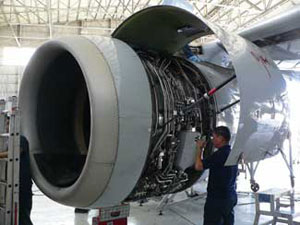Aircraft Engineer
Tasks & duties

Aircraft engineers may do some or all of the following:
-
regularly check the engines, airframe (body of an aircraft) and mechanical systems of aircraft
-
inspect aircraft, look for and diagnose faults
-
repair or replace faulty parts
-
replace parts that have to be changed after being in use for a certain length of time
-
test parts to make sure they work
-
service aircraft
-
keep records of repairs
-
follow set procedures
-
have all work inspected and approved by licensed aircraft engineers
Specialisations
Helicopter Engineer
Helicopter engineers maintain and repair the systems, rotors, body and other parts of helicopters.
Skills & knowledge

Aircraft engineers need to have:
-
knowledge of the structure of aircraft mechanical systems (including jet and propeller engines), and hydraulic and pneumatic (compressed air) systems in aircraft
-
an understanding of how aircraft fly (aerodynamics) and how metals react during flight
-
an understanding of the maintenance requirements of the aircraft they are servicing
-
the ability to diagnose and solve mechanical problems
-
excellent mechanical and technical skills
-
knowledge of approved repair techniques and procedures
-
knowledge of aircraft safety rules and safe work practices
Entry requirements
To become an aircraft maintenance engineer you usually have to complete an apprenticeship or traineeship in Aeroskills (Avionics/Mechanical/Structures). Entry requirements may vary, but employers generally require Year 10. However, some employers will hire staff without qualifications and provide on-the-job training, as well as helping staff to gain qualifications during their employment.
After graduating with an Aircraft Maintenance Engineer (AME) trade certificate and gaining the necessary experience, you may undertake further training to become a Licensed Aircraft Maintenance Engineer (LAME). The qualification for a LAME is a Diploma in Aeroskills plus specific training and experience on aircraft. Alternatively, examinations set by the Civil Aviation Safety Authority (CASA) along with documented experience can be utilised in place of the diploma qualification. The CASA examination is only available until 2015. An aircraft maintenance engineer can only work on aircraft under the supervision of a licensed aircraft maintenance engineer.
Secondary education
Three years of secondary education in English, maths and science, is needed to enter tertiary training.
Training on the job
Many aircraft engineers are trained and gain their qualifications on the job.
Registration
Not all aircraft engineers have to be licensed, but CAA requires all engineering and maintenance work carried out on aircraft to be done under the supervision of a Licensed Aircraft Maintenance Engineer (LAME).
To become licensed, you must satisfy CAA you have sufficient skills, knowledge and experience to work on particular types of aircraft. This involves:
-
paying fees
-
sitting a series of exams
-
being approved as a fit and proper person by the director of CAA
-
undergoing a medical examination
Useful experience
Previous experience in mechanics, panel beating, or working with sheet metal is useful for aircraft engineers. It may also be useful to have a heavy vehicle driver's license.
Related courses
Aircraft Maintenance Engineering
Mechanical Engineering
For more information, please refer to myfuture.
Document Actions
